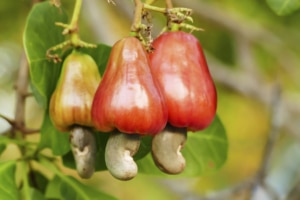As you head to your pantry to fulfill cravings for delicious cashews, do you wonder how they grow? Knowing where your food comes from brings extra appreciation for those who produce it and the nutrition that comes from it. When you’re ready to stock your kitchen with savory nuts and other natural ingredients, count on Glenda’s Farmhouse to provide delicious products with a focus on quality, efficiency, and affordability.
Glenda’s Farmhouse Promises

- We believe in family and community and sharing delicious food with friends and families.
- We believe in good health and quality food that nourishes your body.
- We believe that the land and its trees should be treated with respect, sustaining us as they have for decades.
- We believe in innovation and understand that although farming is traditional, we need technology to thrive in today’s economy.
We operate out of our facilities in Vina, California, and all of our facilities are entirely peanut-free.
Exploring Cashews and How They Grow
Today, cashews are grown in various areas of the world, but they were originally found in Brazil, India, Vietnam, and South East Asia. Tropical climates provide the conditions needed for the cashew tree to thrive.
To grow cashews, you need a cashew tree. First, the cashew apple grows off of the branches of this tree, and then the cashew seed grows from this cashew apple.
The cashew apple is a false fruit. It doesn’t come from the plant ovary and is used as a distraction in the natural world to protect the actual cashew seed. In addition, the fruit is brightly colored red or yellow, a feature that enhances its function as a diversion.
While the nut industry focuses on the cashew seed, the cashew apple is edible, but it’s tough to transport for sale because it tends to spoil. Once the fragile peel breaks, the clock ticks faster and faster.
The seed that we enjoy as the cashew nut grows on the bottom of the cashew apple. Once cashew nuts are fully ripened, they’ll drop to the earth for easy harvest, or workers can harvest them by grabbing them at the bottom of the cashew apple and twisting them to remove the cashew nut.
The cashew nut we enjoy is encapsulated in a shell tainted with poisonous anacardic acid. Cashews must be treated at a high temperature to remove this toxic compound, causing the shell to open. This process helps access the cashew nut and makes it safe to eat.
Store Your Cashew Inventory
Cashews are healthy, nutritious, and very useful in your kitchen. When you buy them, maximize their peak freshness by choosing airtight storage. The longer you need to keep them fresh, the colder the storage should be.
Nutrition Facts about Cashews
Serving size = one ounce = 28 grams = about 18 nuts.
- 165 calories
- <1 gram protein
- 14 grams fat
- 9 grams carbohydrates
- <1 gram fiber
- 1 gram sugar
- Copper – 67% DV (Daily Value)
- Magnesium – 20% DV
- Manganese – 20% DV
- Zinc – 15% DV
- Phosphorus – 13% DV
- Iron – 11% DV
- Selenium – 10% DV
- Thiamine – 10% DV
- Vitamin K – 8% DV
- Vitamin B6 – 7% DV
Knowing how cashews grow and how good they are for you, do you need to know where to buy them? Glenda’s Farmhouse distributes wholesome, quality cashews with speedy delivery and budget-friendly prices. Order online to keep your pantry well stocked for snacking and cooking purposes.



